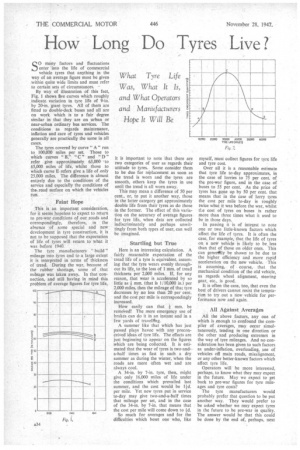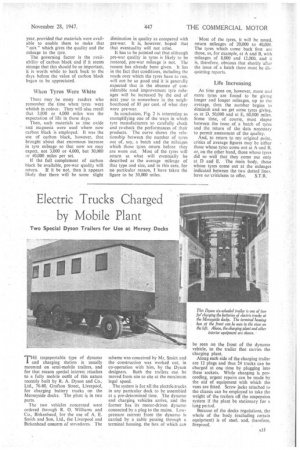How Long Do Tyres Live?
Page 44

Page 45

If you've noticed an error in this article please click here to report it so we can fix it.
SO many factors and fluctuations enter 'into the life of commercial vehicle tyres that anything in the way of an average figure must be given within quite wide limits and must refer to certain sets of circumstances.
By way of illustration of this fact, Fig. I shows five curves which roughly indicate variation in tyre life of 9-in. by 20-in, giant tyres. All of them are fitted to double-deck buses and all are on work which is to a fair degree similar in that they are on urban or near-urban ordinary bus services. The conditions as regards maintenance, inflation and care of tyres and vehicles generally are practically the same in all cases.
The tyres covered by curve " A" run to 100,000 miles per set. Those to which curves "B," "C" and "D" refer give approximately 63,000 'to 65,000 miles of life, whilst those to which curve E refers give a life of only 25,000 miles. The difference is almost entirely due to the conditions of the service and especially the conditions of
• the. road surface on which the vehicles run.
Faint Hope
This is an important consideration, for it seems hopeless to expect to return to pre-war conditions of our roads and correspondingly, therefore, in the absence of some special and new development in tyre construction, it is not to be supposed that the expectation of life of tyres will return to what it was before 1940.
The tyre manufacturers build" mileage into tyres and to a large extent it is interpreted in terms of thickness of tread. During the war, because of the rubber shortage, some of that mileage was taken away. In that connection, and still having in mind this problem of average figures for tyre life, it is important to note that there are two categories of user as regards their attitude to tyres. Some consider them to be due for replacement as soon as the tread is worn and the tyres are smooth, others keep the tyres in use until the tread is all worn away.
This may mean a difference of 50 per cent., or, to put it another way, those in the latter category get approximately double life from their tyres as do those in the former. The effect of this variation on the accuracy of average figures. for tyre life, when data are collected indiscriminately and perhaps unwittingly from both types of user, can well be imagined.
Startling but True Here is an interesting calculation. A fairly reasonable expectation of the tread life of a tyre is equivalent, assuming that the tyre wears evenly throughout its life, to the loss of 1 mm. of tread thickness per2,000 miles. if, for any reason, that wear is accelerated by so little as mm. (that is 1/10,000 in.) per 2,000 miles, then the mileage of that tyre decreases by no less than 20 per cent. and the cost per mile is correspondingly increased.
How easily can that mm. be remo'ved! The mere emergency use of brakes can do it in an instant and in a few yards of traveligng.
A summer like that which has just passed plays havoc with any preconceived ideas of tyre life. The effects are just beginning to appear on the figures which are being collected. It is estimated that the wear of tyres is two-anda-half times as fast in such a dry summer as during the winter, when the roads are more often wet and are always cool.
A 34-in. by 7-in. tyre, then, might give only 16,000 miles of life under the conditions which prevailed last summer, and the cost would be lid. per mile. Yet new tyres put in service to-day may give two-and-a-half times that mileage per set, and in the ease of the 34-in, by 7-in, that means that the cost per mile will come down to id.
So much for averages and for the difficulties which beset one " who, like myself, must collect figures for tyre life and tyre cost.
Over all it is a reasonable estimate that tyre life to-day approximates, in the case of lorries to 75 per cent. of the pre-war figure, and in the case of buses to 55 per cent. As the price of tyres has gone up by 50 per cent. that means that in the case of lorry tyres the cost per mile to-day is roughly twice what it was before the war, whilst tl.e cost of tyres on buses is rather more than three times what it used to be in those days.
In passing it is of intecest to note one or two little-known factors which affect the life cf tyres. It is often the case, for example, that the life of tyres on a new vehicle is likely to be less than that of those on older ones, This can generflly be shown to be due to the higher efficiency and more rapid acceleration on the new vehicle. • This is assuming, of course, • that the mechanical condition of the old vehicle, as regards wheel alignment, steering gear, etc., is good.
It is often the case, too, that even the best of drivers cannot resist the temptation to try out a new vehicle for performance now and again,
All Against Averages
All the above factors, any one of which is enough to confound the com piler of averages, may occur simul taneously, tending in one direction or the other and producing extremes in the way of tyre mileages. And no consideration has been given to such factors as under-inflation, overloading, use of vehicles off main roads, misalignment, or any other better-known factors which affect tyre life.
Operators will be more interested, perhaps, to know what they may expect in the future. May we expect to get back to pre-war figures for tyre mileages and tyre costs?
The tyre manufacturers would probably prefer that question to be put another way. They would prefer to be asked whether we may expect tyres in the future to be pre-war in quality. The answer would be that this could be done by the end of, perhaps, next year, provided that materials were available to enable them to make that " mix" which gives the quality and the mileage to the tyre.
The governing factor is the availability of carbon black and if it seems strange that this should be so important, it is worth while to hark back to the days before the value of carbon black began to be appreciated.
When Tyres Were White
Thera may be many readers who remember the time when tyres were whitish in colour. They will also recall that 3,030 or 4,000 miles was the expectation of life in those days.
Then, such materials as zinc oxide and magnesia were used where now carbon black is employed. It was the use of carbon black, however, that brought about that enormous increase in tyre mileage so that now we may expect, not 3,000 or 4,000, but 30,000 or 40,000 miles per set.
If the full complement of carbon black be available, pre-war quality will return. If it be not, then it appears likely that there will be some slight diminution in quality as compared with pre-war. It is, however, hoped that that eventuality will not arise.
It has to be pointed out that although pre-war quality in tyres is likely to be restored, pre-war mileage is not. The reason has already been given. It lies in the fact that conditions, including the roads over which the tyres have to run, will not be so good and it is generally expected that in the absence 9f considerable road improvement tyre mileages will be increased by the end of next year to somewhere in the neighbourhood of 85 per cent, of what they were pre-war.
In conclusion, Fig. 2 is interesting as exemplifying one of the ways in which tyre manufacturers so carefully check and re-check the performances of their products. The curve shows the relationship between the number of tyres out of, say, a batch and the mileages which those tyres return before they are worn out. Most of the tyres will return at what will eventually be described as the average mileage of that type and size, and in this case, for no particular reason, I have taken the figure to be 30,000 miles.
Most of the tyres, it will he noted, return mileages of 20,000 to 40,000. The tyres which come back first are those, as, for example, at A and B, with mileages of 8,000 and 12,000, and it is, therefore, obvious that shortly. 'after the issue of a batch there must be disquieting reports.
Life Increasing As time goes on, however, more and more tyres are found to be giving longer and longer mileages, up to the average, then the number begins to diminish and we get some tyres giving, as at D, 50,000 and at E, 60,000 miles. Some time, of course, must elapse between the issue of a batch of tyres and the return of the data necessary to permit assessment of the quality. And, to return to my original point, critics of average figures may be either those whose tyres come out at A and B, or, on the other hand, those whose tyres did so well that they come out only at D and E. The main body, those whose tyres come out at the mileages indicated between the two dotted lines, have no criticisms to offer. S.T.R.












































































